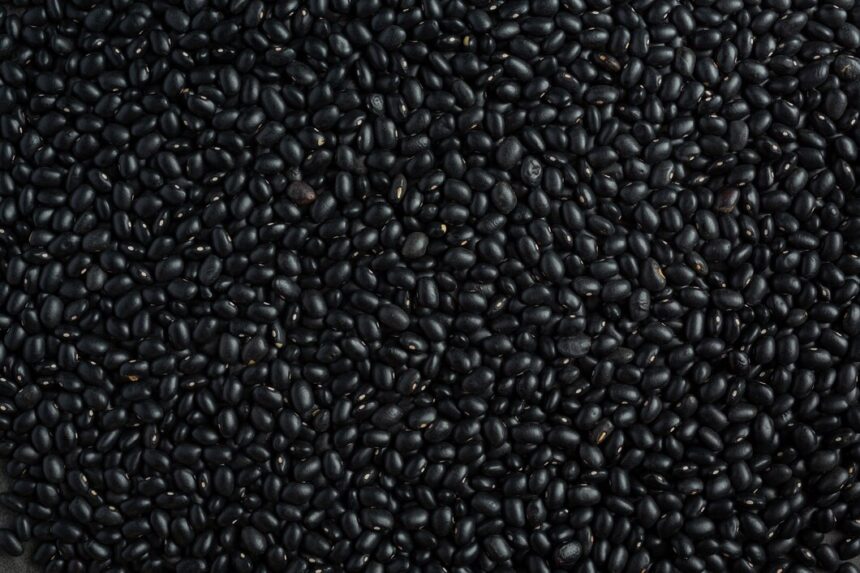Black beans, a nutritious and versatile legume, are gaining popularity in South Africa due to their high protein content and market demand. Growing black beans can be a profitable venture for farmers, but success depends on proper land preparation, understanding growth stages, and managing inputs, pests, and diseases. This article provides a detailed guide for South African farmers, from planting to harvest and storage, with tips on fertilizers, soil requirements, and water management.
1. Land Preparation
Black beans thrive in well-drained loamy soils with a pH range between 6.0 and 7.5. The land should be cleared of weeds, and the soil needs to be well aerated to allow root penetration.
- Ploughing and Tillage: Before planting, deep plough the land to about 20-30 cm to break up compact soil layers. A disc harrow or rotavator can be used to break clods and smoothen the seedbed for uniform seed placement.
- Soil Testing: Conduct a soil test to check for nutrient deficiencies, pH levels, and soil type. This will help you determine the appropriate fertilizers and soil amendments.
- Weed Control Before Planting: Apply pre-emergence herbicides like Pendimethalin or mechanical weeding to control early weed growth.
2. Planting Black Beans
- Seed Selection: Use certified disease-free black bean seeds from trusted suppliers. Black beans germinate best when soil temperatures are between 18°C and 24°C, so planting is recommended during warm, dry conditions, typically in early spring (August-September) in South Africa.
- Seed Rate and Spacing: Plant black bean seeds at a depth of 3-5 cm with a spacing of 40-50 cm between rows and 10-15 cm between plants. The recommended seed rate is around 40-50 kg per hectare.
- Planting Methods: Seeds can be sown using a mechanical planter for large-scale operations or by hand for small plots. Planters ensure uniform depth and spacing, which promotes even germination.
3. Fertilizers and Nutrient Management
Black beans, being legumes, have the ability to fix nitrogen through a symbiotic relationship with soil bacteria, reducing the need for nitrogen fertilizers. However, phosphorus and potassium are essential for strong root development and flowering.
- Phosphorus: Apply superphosphate (200-300 kg/ha) before planting to promote root growth.
- Potassium: Apply potash (50-60 kg/ha) at planting to improve pod development.
- Micronutrients: Ensure adequate levels of micronutrients like zinc and boron through soil amendments if deficient. Farmers can use foliar sprays containing these nutrients if deficiencies appear during growth.
4. Water Requirements and Irrigation
Black beans need moderate but consistent water, especially during flowering and pod development.
- Water Frequency: In South Africa, black beans typically require 400-500 mm of water per growing season. During dry periods, irrigation should be applied every 7-10 days, depending on soil moisture levels.
- Irrigation Methods: Drip irrigation is the most efficient system for black beans, as it minimizes water wastage and reduces the risk of fungal diseases caused by excess water on leaves. However, sprinkler irrigation can also be used in larger fields.
5. Growth Stages of Black Beans
- Germination (7-10 Days): After planting, black bean seeds will begin to germinate in about 7-10 days. Keep the soil consistently moist but not waterlogged.
- Vegetative Stage (2-4 Weeks): The black bean plants will develop leaves and stems during this stage. Ensure proper weed control using post-emergence herbicides or manual weeding, especially within the first month.
- Flowering Stage (5-7 Weeks): During this critical phase, the plants will produce flowers that will turn into pods. It is important to irrigate consistently during this period, as drought stress can lead to flower abortion and reduced yields.
- Pod Development (7-10 Weeks): Once flowering is complete, the pods will develop and mature over the next few weeks. Continue with irrigation but avoid overwatering, as excess moisture can cause fungal diseases.
- Maturity and Harvest (10-14 Weeks): When the black bean pods have turned yellow and the leaves begin to fall off, the crop is ready for harvest. At this stage, the beans inside the pods should be firm and fully formed.
6. Pest and Disease Management
Black beans are susceptible to various pests and diseases, which can significantly impact yields if not managed effectively.
- Common Pests:
- Aphids: These tiny insects suck sap from the plants, weakening them. Control aphids using insecticidal soap or a systemic insecticide like Imidacloprid.
- Cutworms and Leafhoppers: These pests damage leaves and stems. Apply appropriate insecticides like Cypermethrin to control these insects.
- Common Diseases:
- Anthracnose: This fungal disease causes dark lesions on stems, leaves, and pods. It is more common during wet conditions. Control anthracnose by applying fungicides such as Mancozeb or Chlorothalonil, and practice crop rotation to reduce the spread.
- Root Rot: Caused by poorly drained soils, this can kill plants before they mature. Avoid over-irrigation and ensure the field has good drainage.
- Timing for Pesticides and Herbicides: Use herbicides like Clethodim or Bentazon after germination for post-emergence weed control. Insecticides should be applied during early pest infestations, especially before flowering, to avoid damaging pollinators.
7. Harvesting and Storage
Black beans are usually harvested when 80-90% of the pods have matured and dried. The leaves will typically have fallen off by this stage, and the pods should be firm and dry to touch.
- Harvesting Method: For large farms, mechanical harvesters can be used to thresh and collect beans. Smaller farms may harvest manually by pulling up the plants and allowing them to dry in the field before threshing.
- Drying: After harvest, the beans need to be thoroughly dried to reduce moisture content to below 14% to prevent mold and spoilage during storage. Drying can be done in the sun or using mechanical dryers.
- Storage: Store black beans in cool, dry conditions, preferably in airtight containers or sacks to protect against moisture and pests. For long-term storage, beans should be kept in well-ventilated storerooms with consistent temperatures below 20°C.
8. Machinery and Equipment Needed
- Tractor and Plough: For land preparation.
- Seed Planter: For precise planting.
- Irrigation System: Drip or sprinkler systems for efficient water management.
- Herbicide and Pesticide Sprayers: To control weeds, pests, and diseases.
- Harvester/Threshers: For mechanical harvesting (optional for larger farms).
- Dryers: To reduce moisture content in beans before storage.
Growing black beans can be a rewarding and profitable venture for South African farmers, provided that they follow proper land preparation, manage nutrients, and carefully monitor for pests and diseases. By using the right inputs, understanding growth stages, and adopting efficient harvesting and storage practices, farmers can maximize their yields and ensure that their black beans reach the market in the best possible condition.
Join 'Farmers Mag' WhatsApp Channel
Get the latest Farming news and tips delivered straight to your WhatsApp
CLICK HERE TO JOIN






